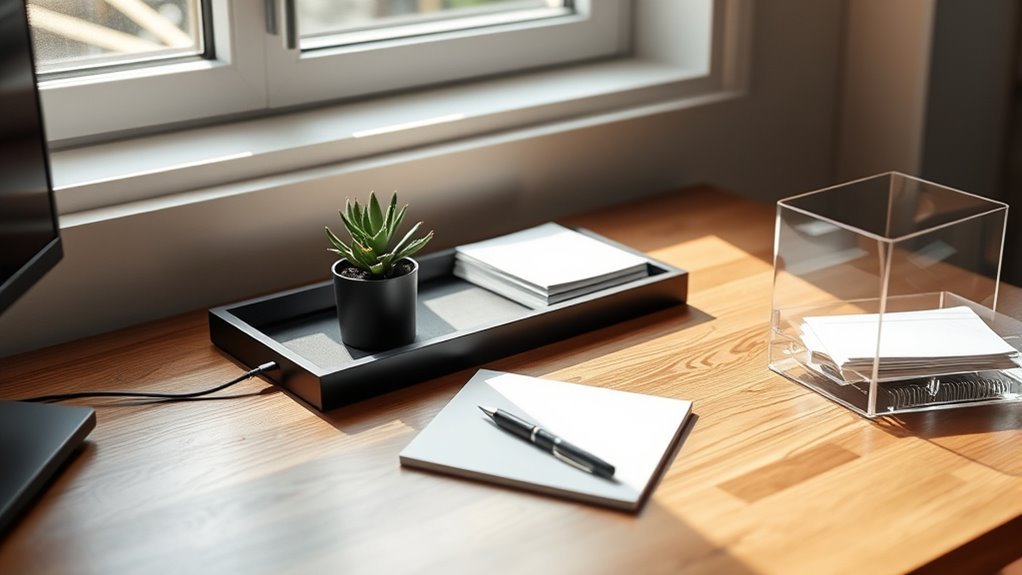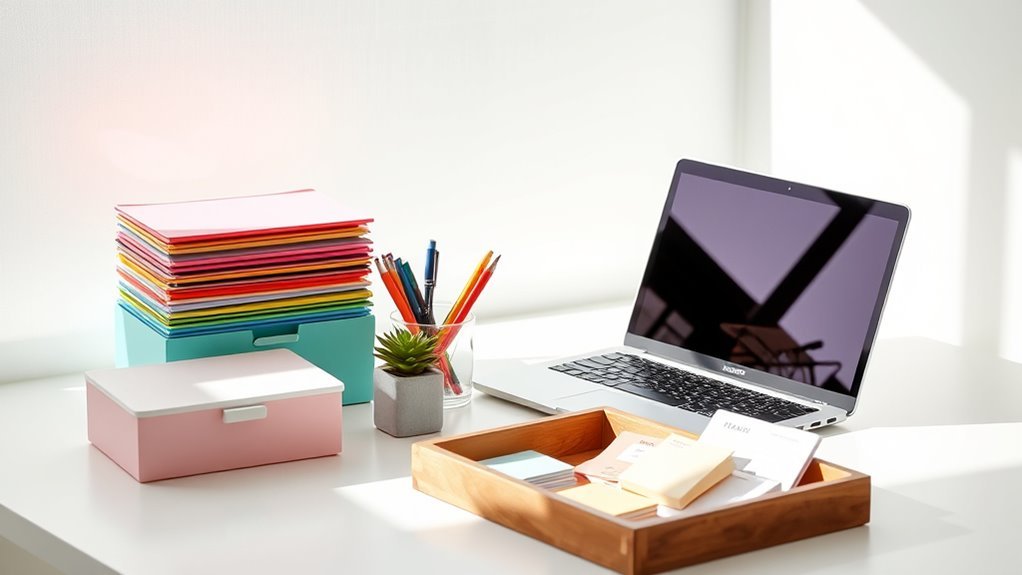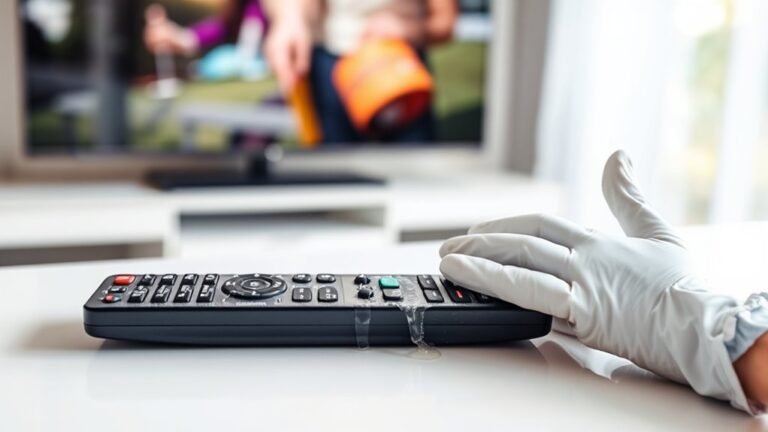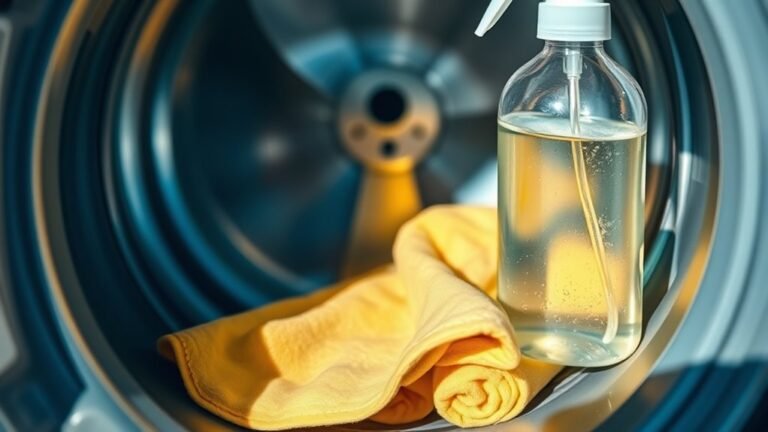Cleaning Tips for a Clutter-Free Desk
You can create a clutter-free desk by first clearing everything off and sorting items into keep, discard, or relocate piles. Focus on keeping only essentials and organize supplies by use and purpose. Manage cables neatly with ties and labels, and set up a paperwork system for easy access and regular purging. Personalize your space with simple, meaningful touches that don’t add clutter. Stick with these habits, and you’ll find even more ways to boost your productivity and calm.
Assess Your Current Desk Setup

Before you can effectively clean and organize your desk, you need to assess your current setup. Take a moment to observe how your workspace feels and functions. Is your chair and monitor positioned to support good desk ergonomics, preventing strain and promoting comfort? Notice if your desk’s layout allows easy access to essentials without clutter. Also, consider the workspace aesthetics—does your desk inspire creativity and calm, or does it feel chaotic and cramped? Identifying these factors gives you the freedom to tailor your environment to your needs. By understanding what works and what doesn’t, you’ll create a foundation for a clutter-free desk that supports productivity and peace of mind. This initial step is key to reclaiming control over your workspace and your day.
Clear Everything Off Your Desk
Start by removing every item from your desk to get a fresh perspective. Once everything’s off, sort the items into categories like office supplies, paperwork, and personal items. This helps you see what you really need and what can be stored or discarded.
Remove All Items
Although it might feel overwhelming, you need to clear everything off your desk to create a fresh, clutter-free space. Removing all items lets you evaluate what’s truly necessary, embracing the minimalism benefits that free your mind. Focus on keeping only desk essentials that support your productivity and peace.
Here’s a quick guide to help you remove items efficiently:
| Item Type | Action |
|---|---|
| Papers | Sort and file or recycle |
| Office Supplies | Keep only what you use daily |
| Personal Items | Limit to a few meaningful ones |
Sort by Category
Sorting your desk items into three clear categories—keep, discard, and relocate—makes decluttering much simpler and faster. Start by examining each item and deciding where it truly belongs. Keep only what you use regularly or inspires productivity. Discard anything broken or unnecessary, freeing you from physical and mental clutter. Relocate items that belong elsewhere to maintain a clean, focused workspace. This method is one of the most effective desk organization methods, helping you prioritize essentials and eliminate distractions. By doing this, you’ll enhance your workspace aesthetic, creating an environment that invites creativity and calm. Remember, a clutter-free desk isn’t just tidy—it’s a step toward reclaiming your freedom and focus throughout the day.
Sort and Categorize Your Items

One effective way to tackle a cluttered desk is to divide your items into clear categories. This helps with item prioritization, making sure essentials are within easy reach while less-used things stay tucked away. A functional arrangement frees your mind and workspace, allowing creativity and productivity to flow without distraction.
Here’s a simple way to visualize your sorting:
| Category | Examples |
|---|---|
| Daily Use | Pens, notebook, phone |
| Reference | Manuals, documents |
| Storage | Supplies, extras |
Declutter Unnecessary Objects
After categorizing your items, it’s time to clear out what you don’t really need. Embracing a minimalist mindset helps you focus on keeping only essential items that truly serve your daily tasks. Ask yourself if each object adds value or just takes up space. If it doesn’t, let it go—this frees up mental and physical room, making your workspace feel lighter and more inviting. Remember, decluttering isn’t about getting rid of everything; it’s about choosing freedom from distractions and chaos. By holding onto only what’s necessary, you create an environment that supports clarity and productivity. This intentional approach guarantees your desk remains a place where your focus can thrive without unnecessary clutter holding you back.
Organize Desk Supplies Efficiently

You can keep your desk supplies easy to find by categorizing them based on how often and for what you use them. Drawer dividers are a simple tool to create separate spaces for each group, preventing clutter from mixing together. This way, everything has its place, and your workspace stays tidy.
Categorize Supplies by Use
Although it might seem simple, categorizing your desk supplies by how you use them can make a huge difference in staying organized. When you group items functionally—like writing tools, paper products, and tech accessories—you create zones that match your workflow. This way, you’re not hunting for what you need, which frees up mental space and keeps your desk clutter-free. Using color coding adds another layer of efficiency, letting you spot essentials at a glance. For example, assign blue for frequently used supplies and red for occasional items. This system isn’t just about neatness; it’s about reclaiming control over your workspace so you can focus on what matters most. Embrace this simple strategy, and your desk will support your productivity, not hinder it.
Use Drawer Dividers
Drawer dividers are a game-changer when it comes to organizing desk supplies efficiently. By using effective dividers, you create designated spaces for each item, making it easy to find what you need without digging through clutter. This simple tool enhances drawer organization, giving you control over your workspace. You can customize dividers to fit your drawer size and the variety of supplies you have, from pens and paperclips to sticky notes and chargers. Embracing drawer dividers frees you from the frustration of messy drawers and wasted time searching. When everything has its place, you’ll feel more focused and ready to tackle your tasks. So, invest in quality dividers and reclaim your desk’s potential for freedom and productivity.
Manage Cables and Electronic Devices
When managing cables and electronic devices, keeping things organized can drastically reduce desk clutter and make your workspace more efficient. Start by grouping cables using simple tools like zip ties or Velcro straps to avoid tangles. Label each cable so you can quickly identify what belongs to which device, saving time and frustration. Use cable management clips or under-desk trays to keep cords off your surface, creating a cleaner look and more free space. For device organization, designate specific spots for your gadgets when not in use—charging stations or small containers work well. This way, your desk stays neat, and you maintain easy access to essentials without feeling trapped by the mess. Embrace these habits, and you’ll enjoy a freer, more productive workspace.
Implement Daily Cleaning Habits
Since maintaining a clutter-free desk requires consistency, implementing daily cleaning habits is essential. By integrating mindful habits into your daily routines, you create a workspace that promotes freedom and focus. Keep your desk clear by making these simple actions part of your day:
- Spend 5 minutes each morning clearing unnecessary items.
- Wipe down your desk surface to keep it fresh.
- Put away tools and supplies immediately after use.
- Review your desk at day’s end to prep for tomorrow.
These small, intentional efforts prevent clutter from piling up, giving you a sense of control and calm. With daily cleaning habits, your desk becomes a space where productivity flows freely and distractions fade into the background.
Utilize Storage Solutions
A few smart storage solutions can transform your desk from cluttered chaos into an organized oasis. Start by using shelf organizers to keep books and supplies neatly stacked, freeing up valuable surface space. Desktop trays are perfect for sorting everyday essentials, so you always know where to find them. Drawer bins help separate smaller items, preventing a jumbled mess inside your desk drawers. Consider wall mounted storage to maximize vertical space without crowding your workspace. Labeled containers add clarity, making it easy to locate what you need quickly. If you want to optimize further, multifunctional furniture like desks with built-in storage can streamline your setup. These solutions give you freedom from clutter, helping your desk stay tidy and your mind clear.
Maintain a Paperwork System
To keep your desk clutter-free, you need a reliable paperwork system that organizes documents efficiently. Make it a habit to regularly purge unneeded papers to prevent buildup. This way, you’ll always have quick access to what matters most.
Organize Documents Efficiently
While it might seem tedious at first, organizing your documents efficiently can save you time and reduce stress in the long run. You want a system that frees you, not confines you. Start by embracing document scanning to reduce paper clutter and enable quick access. Digital archiving lets you store files securely while maintaining easy retrieval.
Here’s how to organize like a pro:
- Sort documents by category (bills, work, personal).
- Use labeled folders or binders for physical copies.
- Create a consistent naming system for digital files.
- Back up your digital archive regularly to avoid loss.
Regularly Purge Unneeded Papers
One key habit you’ll want to develop is regularly purging unneeded papers to keep your paperwork system effective. Holding onto every scrap creates clutter that weighs you down and limits your freedom. Set a schedule—weekly or monthly—to review your documents. Sort what you truly need to keep and digitize important files using reliable digital storage solutions. This not only frees physical space but also makes retrieval easier and faster. For papers you no longer need, commit to paper recycling instead of tossing them in the trash. This small step helps you declutter responsibly, aligning with an eco-friendly mindset. By consistently clearing out unnecessary papers, you create a streamlined, efficient workspace that supports your goal of living and working with less hassle and more clarity.
Personalize Your Space Mindfully
Although adding personal touches can make your desk feel more inviting, you should be selective about what items you include. Desk personalization is all about mindful aesthetics—choosing pieces that inspire without overcrowding your space. Keep your desk free and functional while reflecting your unique style. Consider these tips for personalization:
- Pick a small plant or succulent to bring life without clutter.
- Use a sleek photo frame with a meaningful picture.
- Choose a stylish, minimalistic pen holder for your writing tools.
- Add a subtle scented candle or diffuser to create a calming vibe.
Häufig gestellte Fragen
How Often Should I Deep Clean My Desk Area?
You should deep clean your desk area at least once a month to keep things fresh and clutter-free. Sticking to a regular cleaning schedule helps with desk maintenance and prevents buildup that can cramp your style. If you want more freedom and less stress, try setting reminders so it doesn’t sneak up on you. This way, you’ll enjoy a clear space that boosts your focus and creativity without feeling overwhelmed.
What Are the Best Eco-Friendly Cleaning Products for Desks?
Why settle for harsh chemicals when you can choose natural cleaners that respect both your space and the planet? You’ll find that biodegradable wipes are perfect for quick, eco-friendly touch-ups without leaving waste behind. These products let you keep your desk spotless while embracing freedom from toxins and guilt. Plus, they’re gentle yet effective, making your cleaning routine not just responsible but truly liberating. Isn’t that the kind of freedom you want?
How Can I Prevent Dust Buildup on My Desk?
To prevent dust buildup on your desk, you’ll want to create a consistent dust control and maintenance routine. Wiping down surfaces with a microfiber cloth every few days keeps dust at bay and stops it from settling. You can also use an air purifier to reduce airborne particles. Keeping your workspace clutter-free helps, too, since fewer items mean less surface area for dust to gather. Stick with it, and you’ll enjoy a cleaner, freer space.
Are There Specific Desk Organization Apps Recommended?
Funny you ask about desk organization apps—you’ll find task management tools like Trello and Asana super helpful in keeping your digital and physical space free. These productivity tools let you organize tasks effortlessly, giving you more freedom to focus on what matters. With simple boards and lists, you can clear mental clutter just as easily as your desk, helping you stay on top of things without feeling trapped by chaos.
What Ergonomic Desk Accessories Help Reduce Clutter?
To reduce clutter, you’ll want ergonomic chairs that support good posture, freeing up space by minimizing the need for extra cushions or back supports. Monitor stands are a game-changer too—they lift your screen off the desk, giving you room for storage underneath or just a cleaner surface. Choosing accessories that combine comfort and functionality lets you enjoy a workspace that feels open and under your control, not cramped or chaotic.






